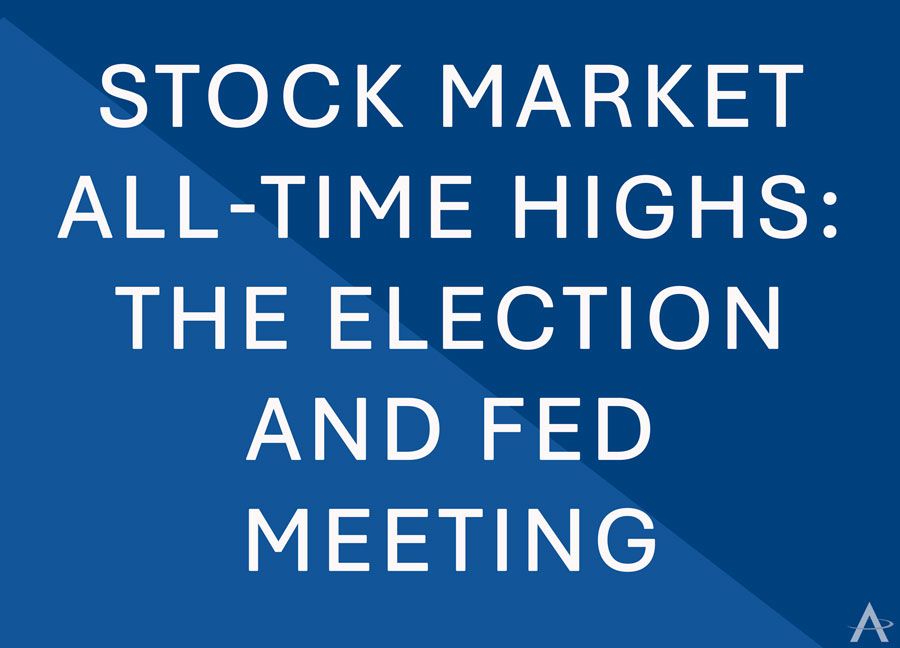Stock Market All-Time Highs: The Election and Fed Meeting

Last week was rewarding for long-term investors, with election results and a Fed meeting providing the catalysts to boost several major stock indexes to all-time highs. Summarizing last week’s trading, the large-cap S&P 500 gained 4.66%, the Nasdaq 100 increased by 5.41%, and the Dow Jones Industrial Average rose by 4.61%. All three of these indexes made fresh weekly all-time-high closes.
Election Boost: S&P 500 Crosses Above 6,000
As last Tuesday's election results were finalized, markets had one thing on their mind: higher stock prices. Wednesday brought us a sharp rally in major stock indexes as government bonds dropped and yields rose. The broadest benchmark of the U.S. economy, the S&P 500 crossed the key psychological level of 6,000 and settled slightly beneath it to close out the week. Long-term investors will take it!
Federal Reserve (Fed) Rate Cut
As widely expected, the Fed cut the benchmark rate by 25 basis points at last week's November meeting — no surprises there. The move is the follow-up to the central bank’s large 50-basis-point cut in September, which brings the current target lending rate range to 4.50% - 4.75. The rate cut vote was unanimous. The move supports the labor market, with further data needed to gauge the current state of inflation. Major stock indexes were steady after the rate decision and subsequent Fed commentary, and stocks closed positively on the day as bond yields traded lower after being higher the day before.
Powell Press Conference
Fiscal Policy: As usual, attention turned to Federal Reserve Chair Jerome Powell’s 2:30 PM press conference after the 2:00 p.m. rate decision release last Thursday. Powell had some memorable responses during the Q&A session, notably some commentary on overall fiscal policy. “The federal government’s fiscal path, fiscal policy, is on an unsustainable path,” Powell said. “The level of our debt relative to the economy is not unsuitable, the path is unsustainable…. And we see that in a very large deficit, you’re at full employment [and] that’s expected to continue, so it’s important that be dealt with,” Powell added. “It is ultimately a threat to the economy.”
“Not Permitted Under Law”: It is widely known that relations between President-Elect Donald Trump and Powell may not be the most amicable, and the question about it came up during last week's presser. When asked if he would step down if the President-elect asked him to, Chair Powell’s response was a resounding, and short: “No.” Questions surrounding the topic surfaced again later in the conference, with another reporter asking if the president-elect had the authority to fire or demote Powell. The Fed chair responded that such an action is “not permitted under law.”
Volatility Fizzles
The most widely watched measurement of stock market volatility, the $VIX, dropped substantially on the heels of the election results and the Fed rate cut. The $VIX, aka Fear Index, closed under $15.00 last week — trading near the summer 2024 lows, indicating investor fear leaving the marketplace. After a down week for volatility and the $VIX declining by over 30% last week, are investors too optimistic in the short term? Objectively, much uncertainty was removed from markets last week, with known election outcomes and a known Fed decision. It will be about the Consumer Price Index (CPI) this week, and we will see how volatility reacts after the best week of 2024 for the S&P 500 and the Dow.
Consumer Sentiment
With all the talk last week surrounding elections and the Fed, what about the consumer? Fresh University of Michigan consumer sentiment data shows the consumer once again remaining resilient and cautiously optimistic. The UoM November consumer sentiment metric rose to a print of 73.0 versus 71.0 expected, much better than estimates.
This Week = CPI
It is that time in the data release cycle, and traders want to know where the nation stands on inflation. With the 25-basis-point cut in the books and government bond yields rising on the open market recently overall, eyes will be peeled on this all-important inflation metric being released this Wednesday morning.
The Takeaway
The start of November is very constructive for long-term investors. With the election out of the way and the market response looking favorable, attention will now shift back to inflation data and the direction of future Fed policy. This week has the data releases (PPI, CPI) that are needed to shape near-term market direction and consensus after a stellar run in major stock market indexes in October and to start in November. November is historically a good month for stock indexes. Bond yields and the U.S. dollar are also in focus right now. We will be staying on top of the latest developments to keep you informed.
As always, if there is anything on your mind regarding the markets and your strategy, please contact us and we will connect to discuss.




